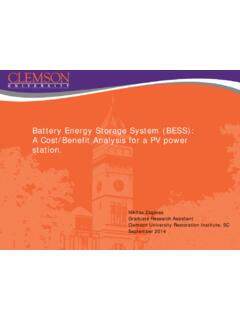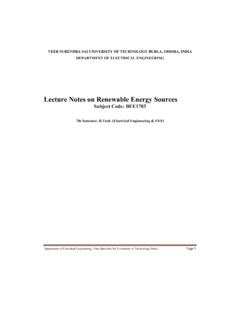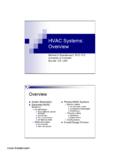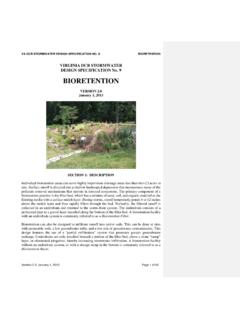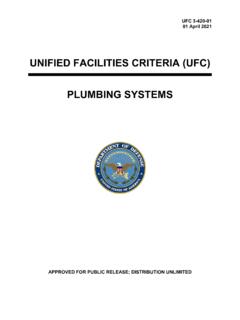Transcription of An Introduction to the Small Wind Turbine Project - NREL
1 NREUCP-440-23158 UC Category: 1213 An Introduction to Small Wind Turbin Trudy L. Forsyth e Project Presented at Windpower '97 Austin, Texas June 15-18, 1997 - =!. - .. National Renewable energy Laboratory 1617 Cole Boulevard Golden, Colorado 80401-3393 A national laboratory of the Department of energy Managed by Midwest Research Institute for the Department Of energy under contract No. DE-AC36-83CH10093 Work performed under task number WE7130 10 July 1997 NOTICE This report was prepared as an account of work sponsored by an agency of the United States government. Neither the United States government nor any agency thereof, nor any of their employees, makes any warranty, express or implied, or assumes any legal liability or responsibility for the accuracy, completeness, or usefulness of any information, apparatus, product, or process disclosed, or represents that its use would not infringe privately owned rights.
2 Reference herein to any specific commercial product, process, or service by trade name, trademark, manufacturer, or otherwise does not necessarily constitute or imply its endorsement, recommendation, or favoring by the United States government or any agency thereof. The views and opinions of authors expressed herein do not necessarily state or reflect those of the United States government or any agency thereof.. Available to DOE and DOE contractors from: Office of Scientific and Technical Information (OSTI) Box62 Oak Ridge, TN 37831 Prices available by calling (423) 576-8401 Available to the public from: National Technical Information Service (NTIS) Department of Commerce 5285 Port Royal Road Springfield, VA 22161 (703) 487-4650 f.
3 Printed on paper containing at least 50% wastepaper, including 20"/o postconsumer waste AN Introduction TO THE Small WIND Turbine Project ABSTRACT Trudy L. Forsyth National Renewable energy Laboratory 1617 Cole Blvd. NWTC Golden, Colorado 80401 USA Small wind turbines are typically used for the remote or rural areas of the world including: a village in Chile; a cabin dweller in the ; a farmer who wants to water his crop; or a utility company that wants to use distributed generation to help defer building new transmission lines and distribution facilities. Small wind turbines can be used for powering communities, businesses, homes, and miscellaneous equipment to support unattended operation.
4 This paper covers the Department of energy /National Renewable energy Laboratory Small Wind Turbine Project , its specifications, its applications, the subcontractors and their Small wind Turbine concepts. Small WIND Turbine MARKETS Small wind turbines are used throughout the developed and developing world and are primarily used in rural or remote settings in the domestic and international markets. Small wind turbines can be used to power communities, businesses, schools, clinics, single households, farms and a variety of equipment. Small wind turbines can be developed to meet the specifications suitable for the domestic and international (developed and developing) markets.
5 Domestic Markets In the United States, 24% of the population lives in rural areas and a growing number live remotely. Most of those individuals have access to the grid, but there is a group of customers where the cost to connect with the utility grid is prohibitive. For those off-grid individuals, diesel generation systems, renewables (solar, wind), and a storage device (batteries) used in combination as a hybrid power system could provide a solution. International Markets Curr ently, 50% of the international rural sector (not necessarily agricultural) population does not have electric An estimated 2 billion people do not have access to electricity. This figure is projected to increase to 3 billion by the year 2030.
6 Within the international market, there are two market groups: the developed countries and the developing countries. In the Organisation for Economic Cooperation and Development (OECD) nations or developed countries, electric needs are met with a mature market, with developed infrastructure and a stable population. OECD nations will experience slow growth in the power market, estimated to be at OECD countries have typical needs for grid-connected technology, which makes this market similar to the domestic market. In developing countries, energy needs are driven by migration to urban areas, growth in per capita income, increased use and manufacture of energy intensive products, and poor efficiency in providing power.
7 Worldwide growth in energy services is expected to be seven times that of the OECD countries ( ).3 The World Bank has estimated that within 15 years, the total energy consumption will be greater in the developing world than in the OECD countries. "At present, in some developing countries, between one-third and one-quarter of available public resources are going into the electric power sector, and these investments are still inadequate. The aggregate investment demand for electricity in the developing countries is $100 billion over the next decade." 4 Small WIND Turbine Project The Department of energy added the Small Wind Turbine Project to the Turbine Research program in 1995 to stimulate the application of advanced technology in that portion of industry that serves specialized markets requiring wind turbines in sizes from 5 to 40 kW.
8 Such systems are deployed in a wide r ge of commercial applications, often high value end-use applications in remote sites that require high reliability over extended periods of unattended operation. The goal of the Small Wind Turbine Project is to help industry develop cost-effective, high reliability Small wind Turbine systems for both the domestic and international wind energy markets. The objective of this Project is to provide tested Small wind Turbine systems, sized from 5 to 40 kW (maximum power), that meet a Cost/Performance Ratio of$ :Wh or less at m/s ( mph) sites and significantly reduce the cost of energy by the year 2000. The systems are also expected to meet certain design requirements such as: high reliability, ease of transportation and installation, low maintenance, International Electrotechnical Commiss-ion (IEC) Class II requirements, and environmental considerations (desert, coastal, cold weather) based on specific markets.
9 The scope of work emphasizes an iterative engineering development process, including formal design reviews at the end of each Project stage and tests to verifY the system design and analyses (see Figure 1). Design and Analysis Phase Test and Evaluation Phase Ali Final Ana1y s Ali Final Lmwings All Final !pecijicoJions ' ,-----' Full Loads Analyses Peiformance Analysis Stress Analysis Buckii ng Analysis Verification/Refinement Partial SojeJy Blade Geometry PreJbninary C<>ntrol Flow Chorls StoJic Loads( ) "'" ,..--Prelrmmary Electrical design Survival Loads Rotor Performance Blade Geometry Initial sizing of components Preliminary , Prototype Tests ,/;;;;.---------' System &ifety Performance Loads Component FIGURE 1 - Small WIND Turbine ENGINEERING DEVELOPMENT PROCESS 2 The first stage will develop a preliminary design for the prototype Turbine based on the subcontractor's market assessment and proposed concept.
10 Stage two will generate detailed designs of components and subsystems, which will be verified through qualification tests. Information obtained in the design process and qualification tests will be integrated into a pre-prototype Turbine design. Stage three will fabricate and test the pre-prototype Turbine at a site chosen by the subcontractor to validate the operational, safety, and structural characteristics of the system design. Pre-prototype test results will be used to refme the system design, as necessary, to complete a final design for the prototype Turbine . Stage four will upgrade the pre prototype test Turbine to the fmal prototype configuration. The prototype Turbine , which is the definitive product resulting from the Small Wind Turbine Project , will be field tested for 1,000 run-time hours at the National Wind Technology Center (NWTC) to evaluate system performance and reliability.










